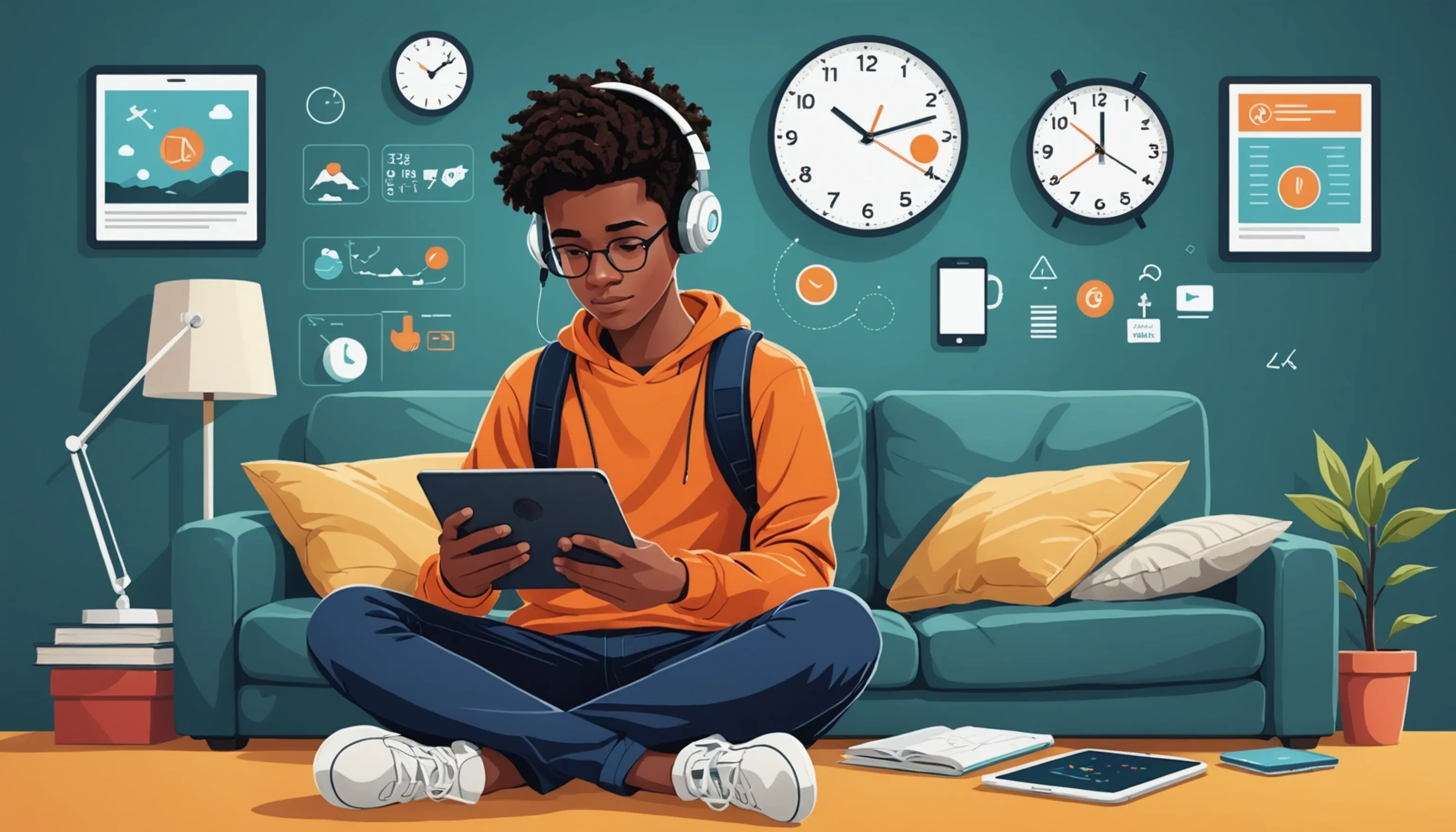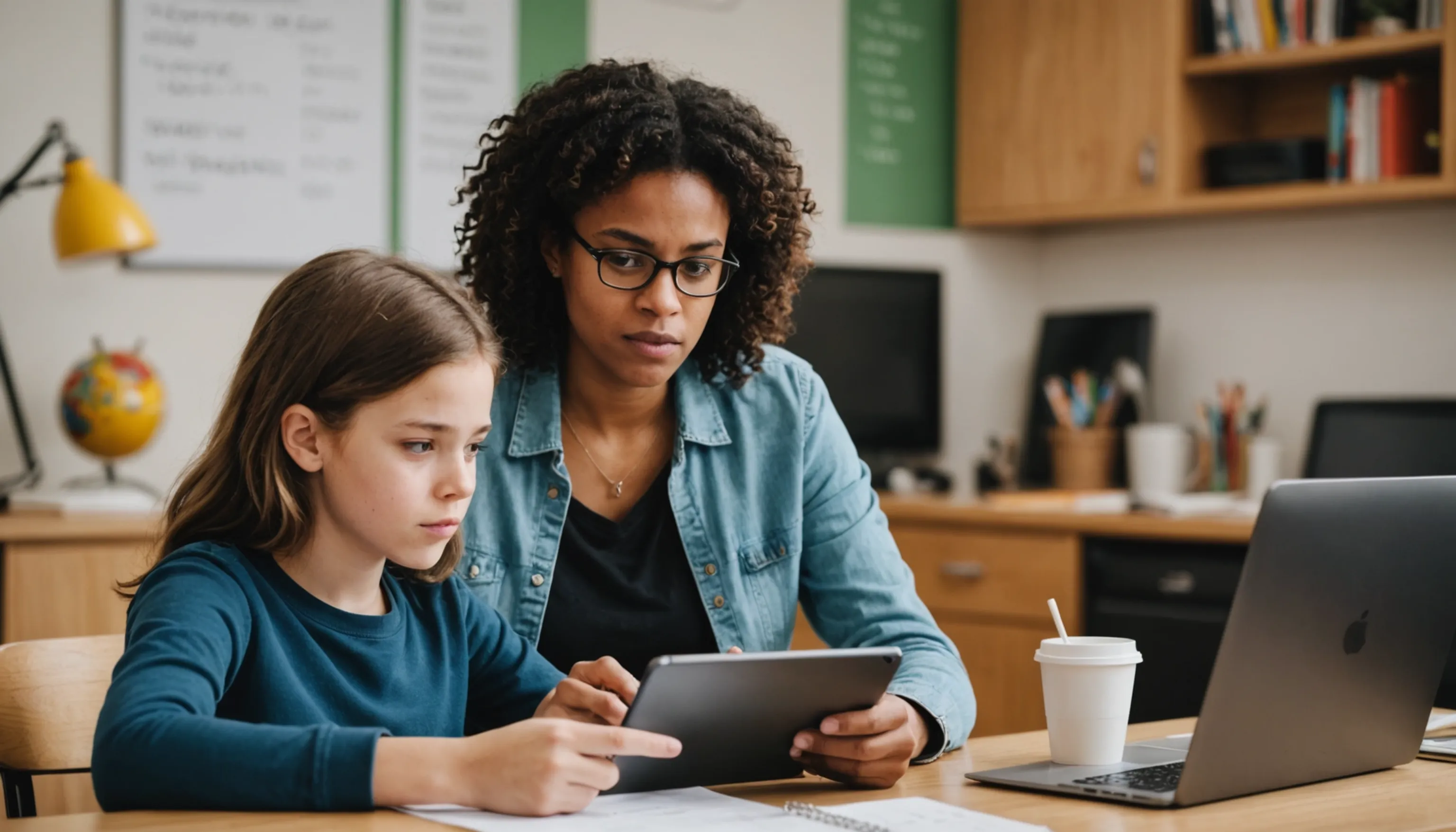Understanding Screen Time for Teenagers
 HvWHenry van Wagenberg
HvWHenry van Wagenberg
Understanding Screen Time for Teenagers
Understanding screen time for teenagers is crucial for parents and teachers alike. It refers to the amount of time spent using devices such as smartphones, tablets, computers, and televisions. With the rise of technology, teens are exposed to screens more than ever before. This exposure can have both positive and negative effects on their development.
While some screen time can provide educational benefits, excessive use can lead to issues such as poor mental health, disrupted sleep patterns, and decreased physical activity. Balancing screen time is essential for promoting a healthy lifestyle among teenagers.
What is Screen Time?
Screen time refers to the duration that individuals, particularly teenagers, engage with digital screens, including smartphones, tablets, computers, and televisions. In today’s digital age, screen time has become a significant part of everyday life, especially for young people who often use devices for various purposes.
There are two primary categories of screen time: educational and recreational. Educational screen time includes activities like online classes, research, and educational apps that contribute to learning and skill development. This type of screen time can enhance knowledge and provide valuable resources for academic success.
On the other hand, recreational screen time encompasses activities such as gaming, social media, streaming videos, and browsing the internet for entertainment. While recreational screen time can help teens unwind and socialize, excessive engagement can lead to negative consequences.
Understanding the balance between these two types of screen time is essential for fostering a healthy relationship with technology. The American Academy of Pediatrics recommends that parents and educators encourage teens to engage in educational screen time while setting appropriate limits on recreational use.
By doing so, adults can help teenagers develop a balanced approach to technology, ensuring that screen time serves as a tool for learning rather than a source of distraction or unhealthy habits.
Types of Screen Time: Educational vs. Recreational
When discussing screen time for teenagers, it's essential to differentiate between two main types: educational and recreational. Understanding these categories helps parents and educators manage screen time effectively.
Educational screen time encompasses activities that promote learning and skill development. This includes using online educational platforms, participating in virtual classrooms, and engaging with interactive learning apps. Research shows that when used appropriately, educational screen time can enhance cognitive skills and reinforce classroom learning. For instance, students can access resources like online tutorials or educational videos that clarify complex subjects. Engaging with educational content can foster curiosity and a love for learning.
In contrast, recreational screen time refers to non-educational activities that primarily serve for entertainment. This includes gaming, browsing social media, watching movies, or streaming content. While recreational screen time can provide relaxation and socialization opportunities, excessive use can lead to negative impacts such as decreased physical activity, poor sleep quality, and mental health issues. It’s crucial for teenagers to have a balance between both types of screen time to ensure they reap the benefits of technology while avoiding its pitfalls.
Encouraging teens to engage in a mix of educational and recreational screen time can help them develop a well-rounded approach to technology. Setting limits and promoting awareness of the content they consume can support healthier screen time habits.

The Impact of Screen Time on Teenagers
The impact of screen time on teenagers is significant and multifaceted. Excessive screen time can contribute to various issues, including mental health challenges such as anxiety and depression. Studies indicate that teens who spend more than three hours a day on screens are at higher risk for these conditions.
Additionally, prolonged screen time can disrupt sleep patterns, leading to insufficient rest, which is crucial for healthy development. It can also reduce physical activity levels, as teens may spend more time sedentary, increasing the risk of obesity. Balancing screen time is vital for promoting overall well-being.
Effects on Mental Health
The effects of screen time on teenagers' mental health are a growing concern for parents and educators. Research has shown that excessive screen time, particularly on social media platforms, can lead to increased feelings of anxiety, depression, and loneliness. When teens spend significant amounts of time online, they may compare themselves to others, leading to negative self-esteem and body image issues.
A study published in the journal JAMA Psychiatry found that adolescents who spend more than two hours a day on screens are at a higher risk of experiencing mental health problems. This increased screen time can also lead to social isolation, as teens may choose virtual interactions over face-to-face connections, which are essential for emotional well-being.
Moreover, the content consumed during screen time plays a crucial role in mental health outcomes. Exposure to cyberbullying, inappropriate content, or negative news can exacerbate feelings of distress and helplessness. Therefore, it is important for parents to monitor the type of content their teens engage with online.
To mitigate these effects, encouraging healthy screen time habits is essential. This includes setting limits on recreational use, promoting educational content, and fostering open discussions about online experiences. By doing so, parents and educators can help teens navigate the digital landscape while prioritizing their mental health and well-being.
Impact on Sleep Patterns
The impact of screen time on teenagers' sleep patterns is a critical issue that has gained attention in recent years. Many teens engage with screens right before bedtime, which can disrupt their natural sleep cycle. The blue light emitted by devices such as smartphones, tablets, and computers interferes with the production of melatonin, the hormone responsible for regulating sleep. As a result, teenagers may find it more challenging to fall asleep and experience poorer sleep quality.
Research indicates that adolescents who use screens for more than two hours before bedtime are more likely to report difficulties in sleeping. A study published in the journal Sleep Health found that increased screen time, particularly in the evening, correlates with shorter sleep duration and increased daytime sleepiness. This lack of quality sleep can lead to a range of issues, including impaired cognitive function, decreased academic performance, and heightened irritability.
Moreover, poor sleep patterns can create a vicious cycle. When teens are sleep-deprived, they may turn to screens for entertainment or social connection, further exacerbating the problem. To combat this issue, it is essential for parents and educators to encourage healthier screen time habits.
Setting a technology curfew, promoting screen-free bedtime routines, and creating tech-free zones in the home can help teens establish healthier sleep habits. By prioritizing sleep and managing screen time effectively, families can support better overall health and well-being for teenagers.

Influence on Physical Activity
The influence of screen time on teenagers' physical activity levels is a growing concern in today's digital age. As teenagers increasingly engage with screens for various activities—be it gaming, social media, or streaming—there is a noticeable decrease in time spent on physical activities. Research suggests that high levels of screen time can lead to a sedentary lifestyle, which is linked to several health issues, including obesity, cardiovascular diseases, and decreased muscle strength.
A study published in the journal Pediatrics found that adolescents who spend more than two hours a day on screens are less likely to meet the recommended guidelines for physical activity. The World Health Organization suggests that teenagers should engage in at least 60 minutes of moderate to vigorous physical activity each day, but excessive screen time often replaces this essential activity.
Moreover, the type of screen time matters. While some screen activities, like fitness apps or online workout videos, can promote physical activity, the majority of recreational screen time tends to be passive. This passive engagement discourages movement and can lead to a cycle of inactivity.
To encourage a more active lifestyle, parents and educators should promote balanced screen time habits. This can include setting limits on recreational screen use, encouraging outdoor activities, and incorporating physical exercise into daily routines. By fostering a culture of physical activity and limiting sedentary screen time, families can help teenagers lead healthier lives.
Managing Screen Time for Teenagers
Managing screen time for teenagers is essential for promoting a healthy balance between digital engagement and real-life activities. Parents and educators play a crucial role in guiding teens towards responsible screen use. One effective strategy is to set clear limits on daily screen time. The American Academy of Pediatrics recommends no more than two hours of recreational screen time per day for teenagers.
Additionally, it's important to encourage open discussions about screen usage. Engaging teens in conversations about the content they consume can foster awareness and critical thinking. Parents can also promote alternative activities, such as sports, reading, or hobbies, to fill the time spent on screens.
Creating tech-free zones or times, like during family meals or before bedtime, can further encourage healthier habits. By implementing these strategies, families can help teens navigate the digital world while ensuring their overall well-being.
Setting Screen Time Limits
Setting screen time limits for teenagers is crucial in ensuring they maintain a healthy balance between digital activities and other important aspects of their lives. With the increasing prevalence of smartphones, tablets, and computers, it is easy for teens to become consumed by screens, often at the expense of physical activity, sleep, and face-to-face social interactions.
One effective approach is to establish clear daily or weekly limits on recreational screen time. The American Academy of Pediatrics recommends that teens engage in no more than two hours of recreational screen time per day. Parents can work with their teens to set these limits, allowing them to have a say in their screen usage, which can foster a sense of responsibility and ownership.
Additionally, it's beneficial to create a family media plan that outlines specific times for screen use. For instance, designating tech-free times during meals or before bedtime can encourage healthier habits and promote family bonding. Utilizing parental control apps can help monitor usage and enforce limits.
Moreover, parents should lead by example. Demonstrating healthy screen habits themselves can influence teens positively. Encouraging outdoor activities, hobbies, and social gatherings can also help reduce screen time and promote a well-rounded lifestyle.
Encouraging Alternative Activities
Encouraging alternative activities for teenagers is essential in managing their screen time effectively. With the allure of digital devices, it can be challenging to motivate teens to engage in non-screen activities. However, providing a variety of options can help shift their focus away from screens and foster a more balanced lifestyle.
One effective way to encourage alternative activities is to promote outdoor sports and physical fitness. Activities such as soccer, basketball, hiking, or cycling not only improve physical health but also offer social interaction and teamwork opportunities. Organizing family outings or joining local sports teams can make these activities more appealing.
In addition to sports, fostering creative interests can divert attention from screens. Encourage teens to explore hobbies like painting, music, writing, or crafting. Providing the necessary materials and space for creativity can spark their interest and keep them engaged.
Volunteering is another excellent way to occupy time constructively. Participating in community service can instill a sense of purpose and responsibility while allowing teens to connect with others in meaningful ways.
Moreover, establishing a routine that includes scheduled screen-free times for family games, cooking, or reading together can strengthen family bonds while reducing screen dependency. By actively promoting these alternative activities, parents can help teens develop a richer, more fulfilling lifestyle away from screens.
Using Technology for Learning
Using technology for learning can be a powerful way to engage teenagers while managing their screen time. When utilized effectively, digital tools can enhance educational experiences, making learning more interactive and accessible. Here are some strategies to integrate technology positively:
- Educational Apps: Encourage teens to explore educational apps that cater to their interests or academic needs. Examples include:
- Khan Academy for math and science
- Duolingo for language learning
- Quizlet for study aids and flashcards
- Online Courses: Promote enrollment in online courses or webinars that align with their career aspirations or passions. Platforms like Coursera, edX, and Udemy offer a variety of subjects.
- Research Projects: Encourage teens to use the internet as a research tool for school projects. Teach them how to find credible sources and evaluate information critically.
- Virtual Study Groups: Suggest forming virtual study groups with peers. This can help foster collaboration and motivation, making study time more enjoyable.
While using technology for learning, it's essential to monitor and guide screen time. Set boundaries around recreational use and ensure that educational engagement remains a priority. By harnessing technology's potential for learning, parents can help teens develop valuable skills while maintaining a healthy relationship with screens.
